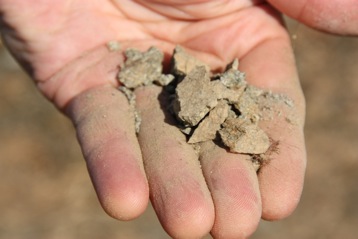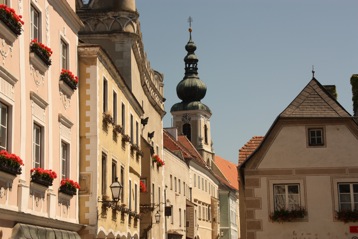 The more I travel, the more I understand that in order to get a true sense of a place, you have to spend time with the people who live there. While I can learn about a culture by going to museums and theatres and restaurants, those experiences often fall short for me. I prefer learning about the culture from those who live it and create it. That’s why I look forward to my day today. I’ll be hosted by Thomas Klinger from Weingut Bründlmayer in the Kamptal region about 45 miles northwest of Vienna.
The more I travel, the more I understand that in order to get a true sense of a place, you have to spend time with the people who live there. While I can learn about a culture by going to museums and theatres and restaurants, those experiences often fall short for me. I prefer learning about the culture from those who live it and create it. That’s why I look forward to my day today. I’ll be hosted by Thomas Klinger from Weingut Bründlmayer in the Kamptal region about 45 miles northwest of Vienna.
Thomas picks me up at my pension promptly at 8:00 AM. Living just outside of Vienna where his wife works, he makes this one-hour commute each day to the winery. He puts me at ease immediately talking the whole time we are in the car, covering topics from the Habsburg Monarchy to Austrian geography and vineyard microclimates. I learn that although there are vineyards all over Austria, the most significant wine regions are in the direction we are headed—the Wachau, Kremstal and Kamptal—in the state of Niederösterreich or “Lower Austria,” a counterintuitive name given that it’s in the north part of the country.
We pull up to the first vineyard at about 9:30 and say goodbye to the air-conditioned car. The vineyard looks lush and green even though the sun is blazing hot. Thomas points out a hillside vineyard across the valley called Heiliegenstein, which translates to “hell’s rock,” a name that feels appropriate right now. Heiligenstein is one of the region’s most highly regarded Riesling vineyards made up of 250 million-year-old desert sandstone and volcanic soils.
I ask Thomas how the vines are so green in the vineyard and all through the hills when we are roasting in the middle of it all. He says the temperature cools down drastically at night, which also helps explain the intensity of flavor in the wines. The heat during the day allows the flavors and aromas to develop while the nighttime coolness locks in the vibrant fruit flavors and the grapes’ natural acidity. As a result you have wines that are not only full of flavor but also mouth-watering and lively because of their great acidity.
In the distance beyond the vines, I see the steeple of a church in the nearby town of Langenlois where we’ll be heading a little later to taste wines at the winery. The vineyard looks different than vineyards I’m used to seeing. The vines are trained using the Lyre trellis system, split to angle out and upward creating a “V” shape visible from the start of each row.
“They are like two sun-worshipping arms,” Thomas says. He tells me that angling the vines this way doubles the exposure to sun and wind, which helps with the grapes’ development of flavors and prevents mildew.
We walk past a section of the vineyard that’s elevated and the soil is exposed beneath the vines. It reminds me of a birthday cake—the row of vines sitting on top like a thick layer of frosting. Thomas pulls a piece off a big rock and crumbles it in his hand, demonstrating how fragile the soil is, which allows the vine roots to break through and penetrate further into the ground to collect nutrients and water.
I like to see the vineyards in person because it helps me understand why the wines taste the way they do. Although I can’t always identify the specific flavors the soil imparts on a wine, I can appreciate that each vineyard site is unique, and differences in the soil or climate can in some way be reflected in the wine. The best winemakers seek to highlight these differences by growing their grapes and making their wine in the most natural way possible. Willi Brundlmayer is one of them.
After visiting a couple of the vineyards, we tasted wines at the winery in Langenlois. The Gruner Veltliners, an Austrian staple, were crisp and elegantly woven with mineral and spice. The Rieslings ranged from delightfully floral to intensely concentrated. The star of the show was the 2001 Heiligenstein Alte Reben Riesling, rich and heavenly with persevering acidity nine years after harvest.
After a whole morning spent with Thomas, we part ways at the medieval town of Krems in the Kremstal wine region named after the river. It is here where the Krems and the Danube Rivers meet. I start my journey in the section of town called Stein, even more off the beaten path than Krems which, although small and far from Vienna, has its touristy moments.
I wander along cobblestone roads just wide enough for one car at a time. People riding bikes with baskets on handlebars pass us from time to time. Home fronts and shop fronts are colorful—pink, salmon, mint green, powder blue, yellow and red—with bright red or pink flower pieces hanging from windows. Some buildings have simple charm and others reflect rich history through intricate architectural details.
I stop at one house that has a tiny garden out front with some old grape vines and what looks like an antique water well. A man rides up on his bicycle and starts talking to me. He looks about 80, a tall, jolly man with bushy eyebrows and a smile that seems to never fade.
“Most of the buildings here in Stein are from the 14th and 15th centuries,” he starts. He tells me about a famous painter who lived up the road and recommends a friend’s café that serves cold meats if I am hungry. “Tell him Gerhard sent you.”
I never do find his friend’s café because its in the opposite direction of the second winery I am visiting. So I find a place to enjoy a cool salad, then make my way back to the main part of Krems to the modern looking Solomon-Undoff Winery and ask for Bert Solomon.
This visit I hadn’t arranged ahead of time, and although Bert is on his way to a meeting, he takes me outside and points to the hills behind his winery covered in vines. He explains that the temperature of the vineyard is influenced by the Danube River and the steep terraces require his Gruner Veltliner to be harvested by hand.
Then he sets me up for a tasting of his wines. Alternating between Gruner Veltliner and Riesling, each wine tastes better than the next. The aromas and pure fruit flavors jump out from the glass. I picture the vineyards in the hills with their cool night air preserving the flavors I am enjoying now.
The train ride back to Vienna takes about an hour and a half and I reflect on another full day well spent. I usually stay away from cities when I travel, but I’ve broken all my rules on this trip. Vienna is wonderful, but it was nice to have one day where I didn’t have to navigate crowds of pushy tourists, pull out a map every few minutes and make heavily weighted decisions on where to eat or what street to take. I could just appreciate my surroundings, talk to locals and taste some of the best wines in the country.
